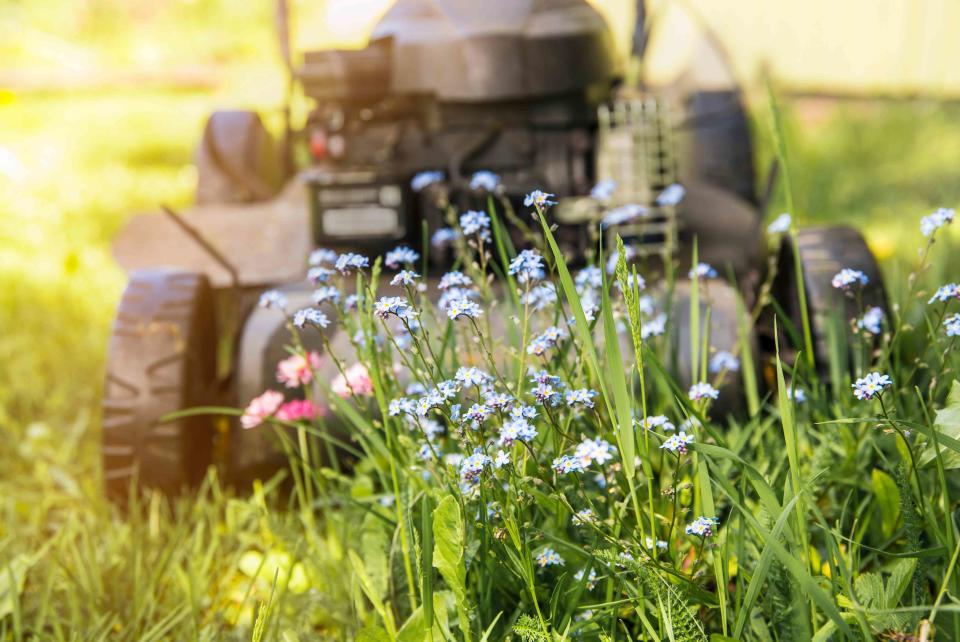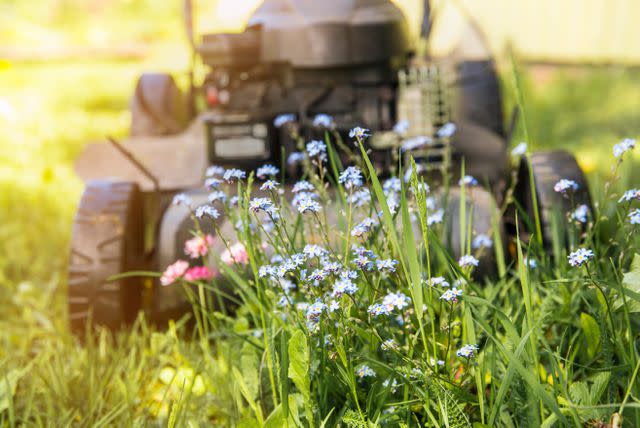After No Mow May, Should You Do a Slow Mow Summer?

No Mow May is a start, but there’s much more you can do to help pollinators.

Helin Loik-Tomson / Getty Images
The last few years have seen the spread of No Mow May, a campaign that encourages folks to mow their lawns and meadows less in order to reduce fossil fuel emissions and water use as well as help wildlife. On the face of it, it seems almost too good to be true–you could do a lot of good things for the environment by doing literally nothing. So perhaps it’s not surprising that letting your lawn grow for a month has fallen short of its promises.
However, No Mow May has provided an important stepping stone for rethinking what pretty means in urban and suburban landscapes, and how these spaces can provide valuable habitat and other environmental benefits. Our yards have the potential to support butterflies, bees, and birds while also cleaning and cooling the air, rebuilding compacted soils, and reducing urban flooding through landscapes that absorb more storm water. To take the next step into creating healthier landscapes for our families and neighbors, we have to understand the flaws of No Mow May and look at these goals with more nuance.
Related: Are Robotic Mowers the Future of Lawn Care?

Helin Loik-Tomson / Getty Images
Why No Mow May Isn’t Such a Great Idea
No Mow May has a few issues that may actually do the opposite of its intended goals. For example, according to Sheila Colla, associate professor at York University and a conservation scientist, the initiative to mow less each May began in the UK, where not mowing “doesn’t necessarily translate well in North America where we have different challenges and need different solutions.”
Allows Invasive Plants to Grow
One challenge is that most of us live on highly altered urban and suburban lots where there is no native plant seed bank. Native plants are critical to feeding butterfly and bee larvae because they co-evolved with many native insect species. What is likely present in the soil are invasive weed seeds–think Canada and musk thistle, as well as aggressive annual weeds like crabgrass–that will provide few resources for wildlife.
Only Temporary Support for Native Bees
In addition, Colla points out that some bee species nest above ground, such as the once-common but now-threatened American bumblebee (Bombus pensylvanicus). Their homes will be destroyed when the mowers come back in June.
One primary study often cited as showing the benefit to bees in the United States was conducted on unmown lawns in Appleton, Wisconsin. It argued that there was a significant diversity of bees present on a diversity of native flowers. The paper has actually been retracted due to errors in plant and bee identification, yet the piece is still often cited.
Related: 5 Easy Ways to Create Gardens for Bees That You'll Enjoy Too
Promotes Less Valuable Flowers
Heather Holm, author and pollinator conservationist, notes that one of the predominant flowering species we’ll see in our lawns are non-native dandelions. While these plants make tasty additions to our salads, and their taproots help amend soil, their pollen is “nutritionally inadequate to support bee larvae on its own, primarily due to the low protein count.”
So even if there are lots of dandelions around, bees still have to expend more energy gathering resources from a greater diversity of flowers, which may or may not be present in an unmowed urban lawn. Bees often exhibit floral fidelity when foraging, which means they tend to stick to one species in bloom to make things easier on themselves and use less energy. But when the primary resource lacks the nutrition to support bee larvae growth and development, a lawn full of dandelions may end up in giving us fewer pollinators.
Focus on Plant Diversity
Scientists at the University of Minnesota Bee Lab suggest an alternative: “Slow Mow Summer.” This concept advocates for mowing infrequently all summer long while reducing lawn spaces in general. This is where you can take the next, exciting step in your landscape to help wildlife. Consider diversifying your space with an increased number of plant species and plant types (herbaceous perennials, grasses, sedges, shrubs, trees), and not just replacing one monoculture with another.
For example, many folks are broadcasting dutch white clover into their lawns as a lawn alternative in the hopes it also provides floral rewards for insects. However, it’s still a near monoculture that also doesn’t serve as a host plant for caterpillars (and caterpillars are important baby bird food in nesting season, not to mention those caterpillars turn into butterflies if they survive the birds).
Holm also points out that exotic clover, which honey bees evolved with and thus commonly use, may act as a “pathogen spillover between honey bees and native bees.” Due to their large numbers and range, honey bees harbor a variety of diseases that they lay on flowers as they pollinate; when a native bee, such as a bumblebee, comes to forage it picks up those pathogens, which can lead to illness, deformity, or death for the bee and its young.
Taken collectively, our native bees provide superior pollination compared to honey bees, while some 25% of them are specialists with specific groups of native plants (meaning the plant and bee rely upon one another as they co-evolved to use each other either for pollen or pollination). One of the best things you can do after being inspired by No Mow May is to garden with plants native to your zip code, and to include a diversity of species that provide floral resources from spring through fall.
Related: 10 Native Prairie Plants That Attract Birds and Butterflies
Avoiding Bad Bugs
Finally, you may be concerned about ticks in a thicker, taller, more diverse landscape that’s mitigating or replacing lawn, like a designed meadow garden. However, recent research indicates these concerns are minimal. For example, a 5-year research study called The Tick Project found that there are fewer ticks in grassy areas compared to wooded ones. A 2-year study by the US Forest Service in Massachusetts showed that even lawn/meadow spaces at 10 inches high did not harbor tick populations.
Best practices will always include spraying yourself with a repellent and doing a body check after being outdoors, but there are a few design strategies that also can help:
Create wider paths through the landscape. Paths help show intention and provide access points, but making them wider helps you avoid brushing up against vegetation where ticks “quest” on leaf edges, reaching out to hitch a ride.
Increase plant diversity and habitat cover. Encourage predators of species that serve as disease vectors by including habitat for them. Think owls, foxes, and coyotes, who prey on white-footed mice, a vector for lyme disease that ticks catch when feeding on the mice.
Choose shorter plants. Keep your plants under 2-3 feet tall. Pollinators still will have plenty to forage, but it will reduce the attractiveness to ticks.
When creating a diverse landscape in place of lawn, a sign explaining what’s going on and why helps a lot when it comes to staying on good terms with your neighbors and your local weed ordinance enforcers. A few habitat certification programs offer sturdy ones.
Taking the Next Step
What No Mow May began in other parts of the world we can take to the next level wherever our home landscapes may be. By reducing lawn and using a diverse mix of native plants matched to the site (soil, light, moisture), you’ll use less water and fertilizer while supporting caterpillars and bees. You’ll also increase ecosystem services through that plant diversity such as mitigating storm water runoff via dense, layered landscapes that also help clean and cool our urban air.
So go ahead and take a Slow Mow Summer if you want to as you think about how you can really move the needle in your yard. I suggest visiting a meadow example nearby wherever you live to get inspiration from the plant species that thrive there. Watch as native bees forage on blooms and birds nab caterpillars and beetles to feed their young. Then, through organizations such as Pollinator Partnership, the Xerces Society, Wild Ones, Audubon, and the National Wildlife Federation, learn more about those plant species and the wildlife they support so you can recreate the ecosystem in your yard.
Why? Because your landscape matters and can help turn the tide for a healthier, more resilient future that a monoculture of lawn (mowed or unmowed) will never provide.
For more Better Homes & Gardens news, make sure to sign up for our newsletter!
Read the original article on Better Homes & Gardens.

